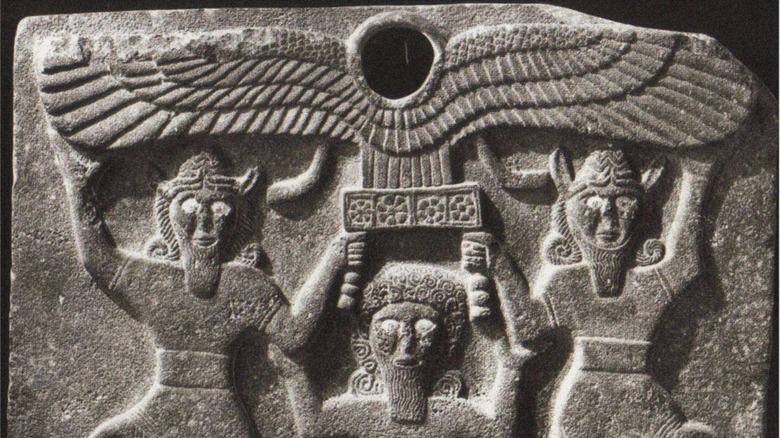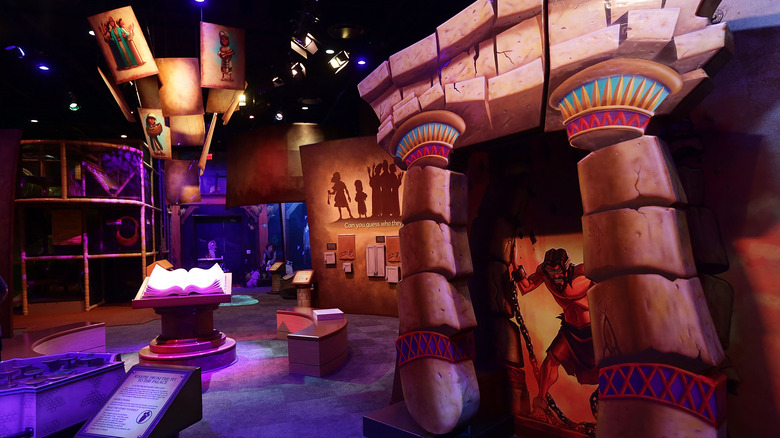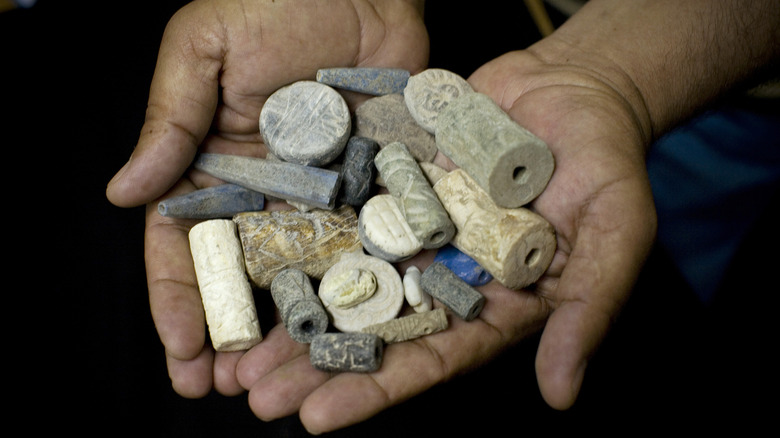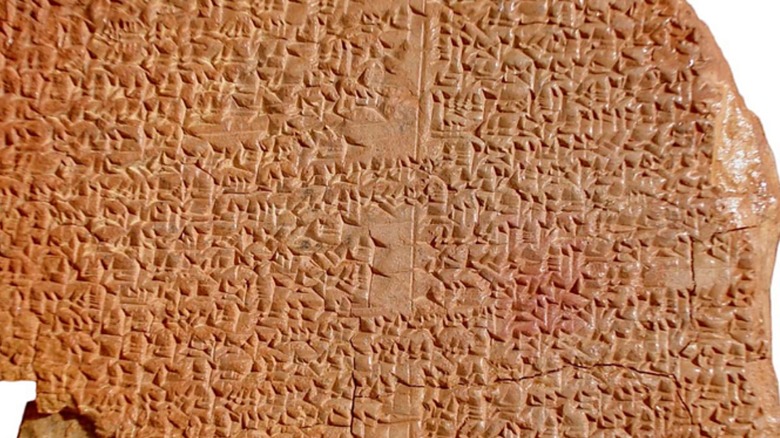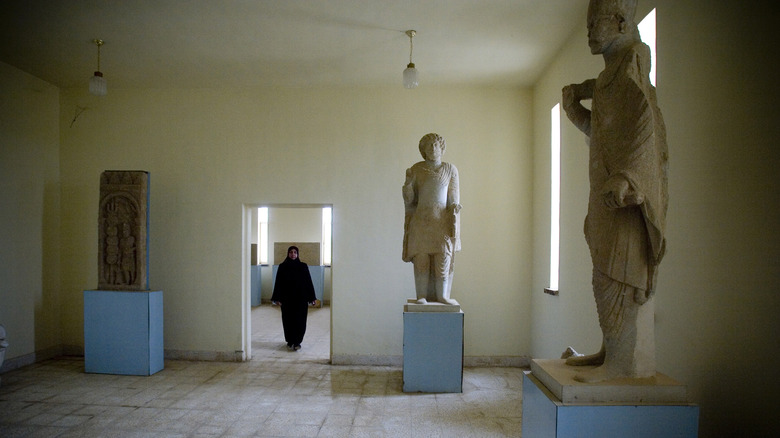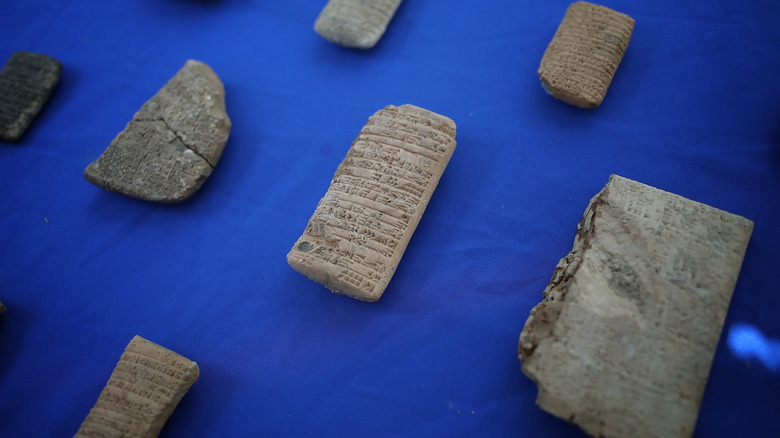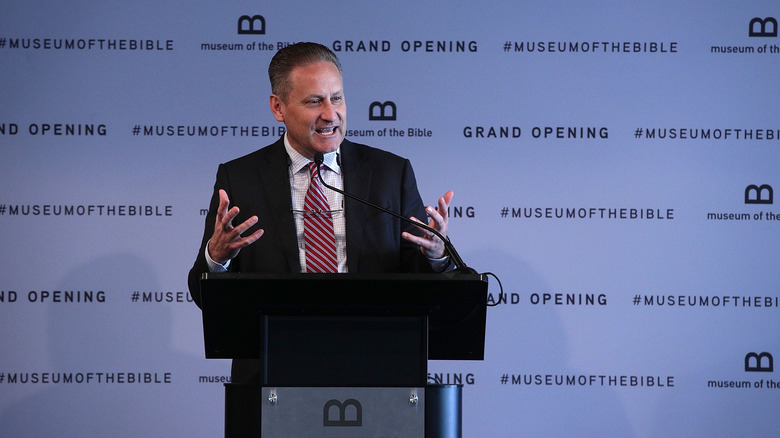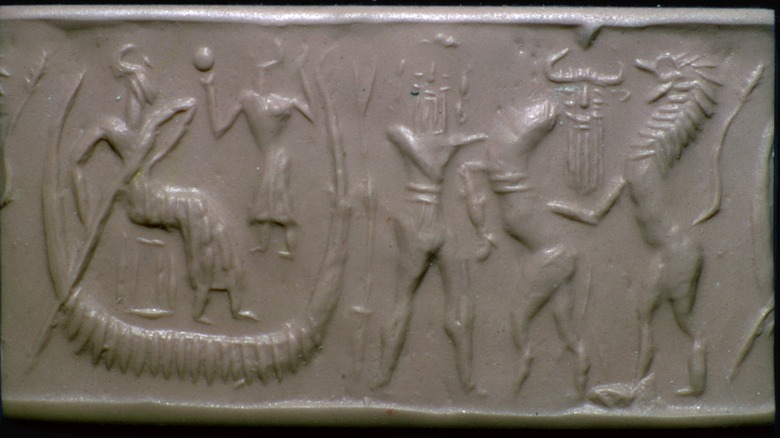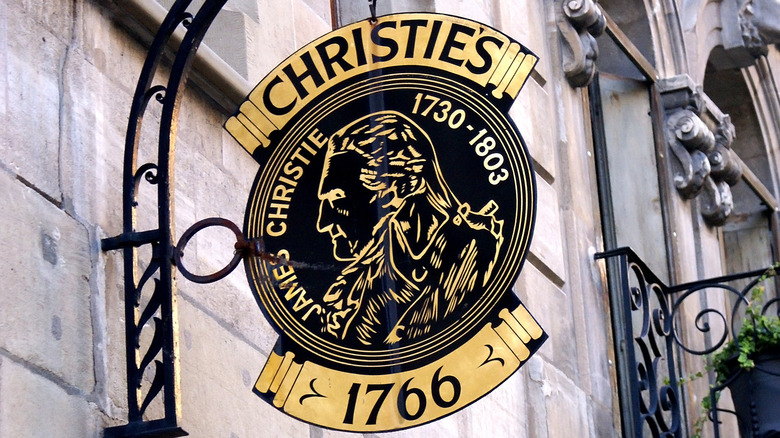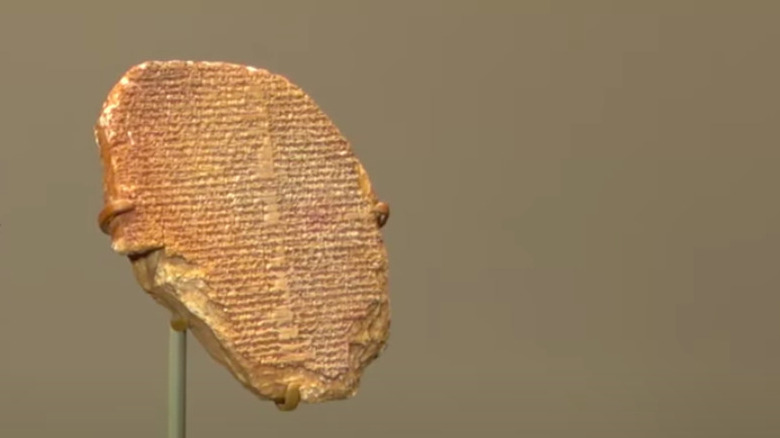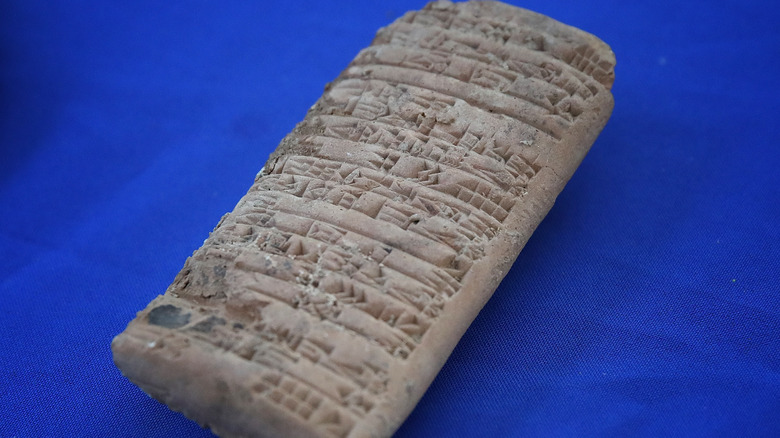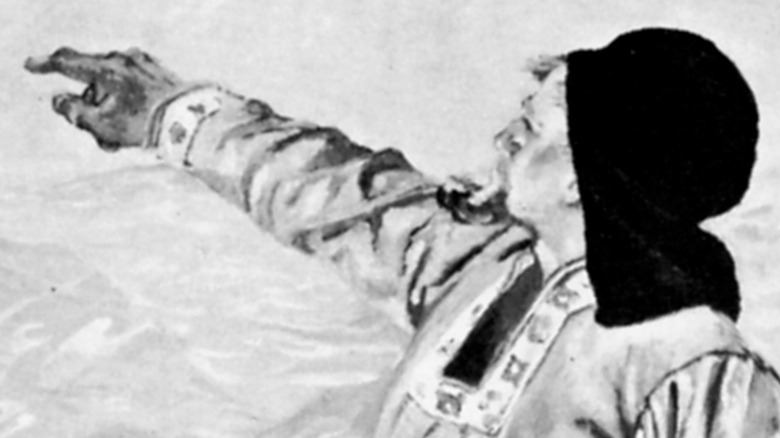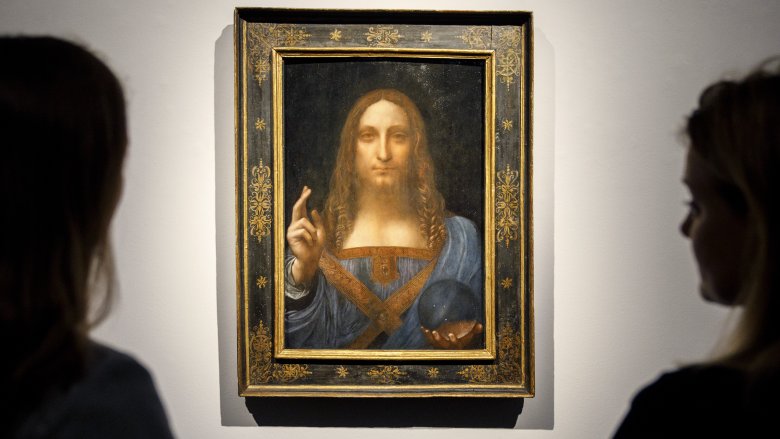
Gilgamesh Dream Tablet: The Untold Truth
In August 2021, a plane touched down in Iraq, carrying with it over 17,000 archeological artifacts that had been looted from the country through recent years. Several thousand artifacts were repatriated by Cornell University, which never consulted Iraq on the research of the tablets, according to Hassan Nadhem, the Iraqi Minister of Culture, Tourism, and Antiquities. But the vast majority of items were returned by Washington, D.C.’s Museum of the Bible, which was founded and funded by the family that owns Hobby Lobby. Among those artifacts was a fragment of a clay tablet telling the Epic of Gilgamesh.
Looted art in museums isn’t anything new, and there are numerous examples of operations focused on repatriating antiquities from American museums. But what was the Museum of the Bible doing with so many items of unknown provenance, and why did it take so long for the institution to return the artifacts to their country of origin? And at the end of the day, what responsibility do collectors have towards the people whose artifacts they seek to possess? This is the untold truth of the Gilgamesh Dream Tablet.
What is the Epic of Gilgamesh?
“The Epic of Gilgamesh” is one of the oldest epics in history, and some of the oldest tablets about the hero-king Gilgamesh, the Old Babylonian tablets, date back past 2000 B.C. As explained by A. R. George in his paper “The Epic of Gilgamesh,” there is “no single ‘Epic of Gilgamesh’: parts of different versions survive, spread across eighteen hundred years of history.” What is commonly referred to as “The Epic of Gilgamesh” today typically refers to the Standard Babylonian version, which was written in cuneiform around 1300 to 1000 B.C.
“The Epic of Gilgamesh” tells the story of Gilgamesh, the king of Uruk, a Sumerian city-state, and the various adventures he goes on with his companion Enkidu. According to The Conversation, “The Epic of Gilgamesh” explores the meaning of being human and questions what life and love are really about. Providing numerous solutions to these questions, the text pulls the reader to question alongside Gilgamesh.
The Gilgamesh story is believed to have originated in Mesopotamia, what is now modern-day Iraq, Iran, Syria, Kuwait, and Turkey, and is thought to be based on a historical king who appears in contemporary inscriptions, per History on the Net. “The Epic of Gilgamesh” was also well-known during antiquity, and is even considered to have impacted later literary works like the Homeric epics.
The BBC reports that the a 12-tablet collection of tablets telling the story was discovered in 1853 in what remained of the library of Assyrian King Assur Banipal.
What is the Museum of the Bible?
Located near the National Mall in Washington, D.C. in the United States, the Museum of the Bible opened in 2017. According to NPR, the museum was opened with the intention of “engag[ing] a wider audience with the Bible” and its history. The museum was created as a “personal passion project” of the Green family, which owns Hobby Lobby, an arts and crafts chain store, and was actually established in 2009 as a 501(c)(3) nonprofit, Vox reports.
The Museum of the Bible features six floors of exhibits, ranging from various historic translations to a recreation of a Palestinian village. However, the museum soon became associated more with scandal than it was with the Bible.
According to Hyperallergic, Hobby Lobby repeatedly reported the appraised value of items that it donated to the museum to be three times that of the purchase price, giving the company an elevated tax write off. Some fragments of the Dead Sea Scrolls were revealed as forgeries after they were put on display at the Museum of the Bible. By the time it was discovered that the scrolls were not genuine, Hobby Lobby had probably already received a tax break.
The organization also became known for acquiring items “so haphazardly” that any paperwork regarding how the artifacts came onto the market was incredibly vague, creating problems of provenance.
The looting of the National Museum of Iraq
One day before U.S. forces arrived and occupied Baghdad, Iraq on April 9, 2003, the staff of the National Museum of Iraq vacated the museum. The museum staff returned on April 12, but between April 10 and April 12, an estimated 15,000 items were looted from the museum.
Smithsonian Magazine writes that American troops eventually arrived to protect the museum on April 16, having been busy bringing down the statue of Saddam Hussein, but by that point the damage was already done. However, thanks to the prudence of museum staff, the damage was slightly mitigated, according to The Conversation. Before vacating the museum, staff members had safely removed and stored almost 9,000 artifacts and thus spared them from the looting. Although up to 7,000 of the stolen items have managed to find their way back, either being recovered in raids or reappearing in other museums, up to 8,000 items are still missing.
In “A Brief History of Iraq,” Hala Mundhir Fattah and Frank Caso write that the National Museum of Iraq wasn’t the only cultural institution that suffered due to the 2003 invasion of Iraq. The main building of the Iraq National Library and Archives went up in flames, resulting in a loss of 25% of the library’s collection and 60% of the archive collection. Military helicopters also damaged numerous archeological sites, including the 6th century B.C. temples of Nabu and Ninmah.
The briefest consultation
Around 2009, Hobby Lobby started collecting antiquities and cultural materials. And although Hobby Lobby consulted Patty Gerstenblith, an expert on cultural property law who told them that “acquisition of cultural property likely from Iraq, including cuneiform tablets and cylinder seals, carries a risk that such objects may have been looted from archaeological sites.” Gerstenblith advised the company to review and verify its existing collection, but these warnings were ignored, according to the United States Department of Justice.
In an interview with Chasing Aphrodite, Gerstenblith states that she gave a presentation to 10 to 15 Hobby Lobby executives, including president Steve Green, and was also asked by Hobby Lobby’s in-house counsel to write a summary of her presentation. In her summary, Gerstenblith specifically advised Hobby Lobby that cultural artifacts looted from Iraq after 1990 are “specifically protected by import restrictions that carry criminal penalties and fines.” But this memorandum was reportedly never shared with Hobby Lobby’s president, executives, or “anyone involved in the [subsequent] purchase and importation” of artifacts from Iraq.
Hobby Lobby smuggles in Iraqi artifacts
In December 2010, Hobby Lobby purchased over 5,500 cuneiform tablets, cylinder seals, and other artifacts for $1.6 million. The acquisition was reportedly “fraught with red flags.” Hobby Lobby was given conflicting information about where the artifacts were kept before being transported to the United Arab Emirates, and when Hobby Lobby’s president Steve Green and his acquisition advisor, Scott Carroll, arrived to inspect the artifacts on July 15, 2010, the pieces were displayed without protection. Sellers claimed to have acquired the artifacts “in the late 1960s from ‘local markets,'” according to the Center for Art Law.
When the packages arrived from the UAE-based dealer to three different corporate addresses in Oklahoma City, Oklahoma, they didn’t have the required accompanying customs entry documentation and were misleadingly labeled as containing “ceramic tiles” or “hand made clay tiles (samples).”
Since the requirements for a package’s customs clearance is based on its value, by valuing each package as less than $2,500, a buyer or seller can ensure an item is cleared under a more informal entry process. Hobby Lobby declared that the packages it imported were valued between $250 and $300 each, but when Customs and Border Patrol seized the packages, they discovered that the contents of each package was valued between $14,000 and $84,000.
Carroll’s assistant reportedly told the UAE dealer that “[a]s long as you keep the value of each package under $2,000, they will not have to forward it to our broker to clear it through Customs.”
Importing Iraqi cultural property
Under Iraqi law, as of 1975 all movable and immovable antiquities are considered “property of the state.” A private person is typically unable to own antiquities, unless it’s registered, authorized, and approved by the government. The export of antiquities is also prohibited.
The United States imposed a general ban on the importation of any item from Iraq with the Iraqi Sanctions Regulations in 1990. The United Nations passed a similar resolution in on August 6, 1990, declaring that all states were to prevent “the import into their territories of all commodities and products originating in Iraq or Kuwait.”
In 2004, this general ban was lifted and amended into more limited restrictions, which included a ban on importing any “Iraqi cultural property or other items of archeological, historical, cultural, rare scientific, and religious importance illegally removed from the Iraq National Museum, the National Library, and other locations in Iraq since August 6, 1990,” per United States of America v. Approximately Four Hundred Fifty Ancient Cuneiform Tablets and Approximately Three Thousand Ancient Clay Bullae.
The Iraqi Sanction Regulations were replaced with the Iraq Stabilization and Insurgency Sanctions Regulations in 2010, which also prohibited “the trade in or transfer of ownership or possession of Iraqi cultural property or other items of archeological, historical, cultural, rare scientific, and religious importance” that have been looted, “or for which a reasonable suspicion exists that they were illegally removed” since August 6, 1990.
Seized by US Customs and Immigration
In January 2011, Customs and Border Patrol intercepted approximately half of the 10 packages Hobby Lobby was sent that month, and all of their shipping labels falsely declared the artifacts’ country of origin to be Turkey. In September 2011, Hobby Lobby received another package from the same purchase, containing roughly 1,000 clay seals. This one also came with a false declaration, which claimed that the artifacts’ country of origin was Israel.
Al Jazeera reports that the false Israeli export license on the package of clay seals “must have been issued by an Israeli [government official],” which is an additional cause of concern.
Meanwhile, Hobby Lobby didn’t even directly pay the UAE dealer, who was the supposed owner of the artifacts, and instead wired money to “seven different personal bank accounts of five other individuals,” according to “Fighting the Illicit Trafficking of Cultural Property.” This was supposedly done based on instructions from another dealer.
Approximately 3,400 artifacts
On July 5, 2017, the United States government filed a civil complaint regarding the artifacts, resulting in the amusingly named lawsuit, United States of America v. Approximately Four Hundred Fifty Ancient Cuneiform Tablets and Approximately Three Thousand Ancient Clay Bullae, since the objects themselves were the defendants in the case.
Such cases are not uncommon, and according to Consumerist, are known as “in rem jurisdiction.” The objects are named as the defendants because they were obtained or created through illegal activity. Other such cases include United States v. Ninety-five Barrels (More or Less) Alleged Apple Cider Vinegar and United States v. Approximately 64,695 Pounds of Shark Fins.
Initially, Hobby Lobby defended its right to the stolen artifacts and filed an administrative petition to get the seized property back. Throughout this time, Scott Carroll, who was still consulting with the Museum of the Bible until 2012, kept traveling and purchasing more artifacts of unknown provenance. In 2013, the Museum of the Bible arranged to buy four gospel papyrus fragments, which later turned out to have been stolen from the EES Oxyrhynchus collection.
Hobby Lobby settles
Hobby Lobby ultimately agreed to forfeit the artifacts in addition to paying a $3 million fine, claiming that it was an unintentional oversight. According to the statement released by Hobby Lobby, the company claimed that it was “new to the world of acquiring these items, and did not fully appreciate the complexities of the acquisitions process.” It said that this “resulted in some regrettable mistakes” and claimed that the company “imprudently relied on dealers and shippers who, in hindsight, did not understand the correct way to document and ship these items.”
Hobby Lobby’s president, Steve Green, also insisted that Hobby Lobby cooperated with the government throughout the investigation and that with the announcement of the settlement, he considered the matter to be resolved. However, the approximately 450 ancient cuneiform tablets and approximately 3,000 ancient clay seals wouldn’t be the only objects that the United States government had to seize from Hobby Lobby.
United States v. One Cuneiform Tablet
In 2014, Hobby Lobby purchased a cuneiform tablet of a scene from the Epic of Gilgamesh, known as the Gilgamesh Dream Tablet, from a private sale at Christie’s for $1.67 million. A part of the 12-tablet collection discovered in the remains of the library of King Assur Banipal, the BBC reports that the tablet is over 3,500 years old.
According to Reuters, the Gilgamesh Dream Tablet is believed to have been purchased by an unnamed antiquities dealer in 2003 in London from a Jordanian dealer. In 2007, when selling the tablet, the London dealer claimed that it was from a 1981 public auction by Butterfield & Butterfield in San Francisco. It’s unclear how many different people had the tablet between 2007 and 2013, but according to The Art Newspaper, Joseph David Hackmey, an Israeli businessman and art collector, consigned it to Christie’s for sale, and sometime in late 2013, Hobby Lobby reached out to the auction house about purchasing it.
In September 2019, the cuneiform tablet was seized from the Museum of the Bible by federal agents. Hobby Lobby claimed that it had only learned that the artifact was likely stolen when its representatives met with federal agents in January 2020.
On July 27, 2021, the Department of Justice ordered the forfeiture of the Gilgamesh Dream Tablet, which Hobby Lobby consented to “based on the tablet’s illegal importations” in 2003 and 2014.
Hobby Lobby sues Christie's
In May 2020, Hobby Lobby filed a lawsuit against Christie’s, claiming that while it had been offered assurances of the artifact’s legitimate provenance, Christie’s knew that the Gilgamesh Dream Tablet’s provenance was fake. Meanwhile, according to the government’s forfeiture suit, the woman who headed Christie’s antiquities department was told that “the provenance was not verifiable and would not hold up to scrutiny in a public auction,” per Reuters.
The Art Newspaper reports that Hobby Lobby is looking for a refund of the $1.67 million it paid for the tablet, as well as attorney’s fees and interest. A spokesperson for Christie’s claims that the auction house had absolutely no knowledge of the illegal importation or original fraud associated with the tablet, and that any illegal activity “predated Christie’s involvement,” per Forbes.
Hobby Lobby also claims that Christie’s fraudulently sold them a gospel manuscript that was looted during World War II from a Greek monastery. In October 2020, Hobby Lobby announced that it was going to return the manuscript to the Greek Orthodox Church.
Returning the Gilgamesh Dream Tablet
On September 23, 2021, the Gilgamesh Dream Tablet was returned to Iraq. According to the Department of Justice, at a repatriation ceremony for the tablet at the Smithsonian Institution’s Museum of the American Indian in Washington, D.C. a ceremonial certificate was signed, transferring the ownership of the tablet to Iraq from the United States.
According to NBC News, UNESCO believes that the Gilgamesh Dream Tablet was originally looted from an Iraqi museum after the beginning of the first Gulf War in 1991.
Fareed Yasseen, the Iraqi ambassador to the United States, spoke at the repatriation ceremony, saying “The looting of the museum hit our core because our history is really important to us. Our history is what makes us. We’re an old country. In fact, I can say we’re the oldest country. And so, you can’t take that from us. And this is why this ceremony and this event and the attachment to our artifacts is so deeply rooted amongst Iraqis.”
11,500 more artifacts of dubious origin
In 2020, Steve Green announced that he was also in the process of repatriating up to 11,500 items from antiquity to the Egyptian and Iraqi governments. Telling the Wall Street Journal that he “knew little about the world of collecting,” Green decided to return thousands of artifacts because their provenance can’t be verified. Although the Museum of the Bible often spins these stories as a gracious return, it’s worth wondering why Green was even purchasing such artifacts in the first place.
According to Artnet, Green claimed that the Museum of the Bible was going to return 5,000 ancient papyrus scraps and 6,5000 ancient clay pieces. However, The Daily Beast reports that the proposed agreement between Hobby Lobby, the Museum of the Bible, and organizations in Iraq has been described as “exploitative and degrading.”
In addition, in 2020, Hobby Lobby promised $15 million to fund “a program to help strengthen the institutional, technical, and human resource capacities of Iraq’s antiquities sector.” But Dr. Zainab Bahrani, professor of art history and archeology, questions whether or not Hobby Lobby is even qualified to assist in anyway, considering that “this company and its museum have been involved in the illicit trade in antiquities, and that scholars associated with it have participated in destructive practices with ancient artifacts that would be condemned by the international community of scholars and scientific conservators who are experts in this field.” It’s unclear if the program was created, but the items were returned.

Cholera Is Responsible For Modern Sewer Systems. Here's Why

Here's How The Great Chicago Fire Really Started

The Truth About The Deadly Luna Park Ghost Train Disaster

Deadliest Poisons In The World

The Messed Up Truth About Joan Crawford

The Sequel To Mein Kampf No One Has Ever Heard Of

Crazy Stories Of Athletes Who Were Stripped Of Their Olympic Medals

Scariest Places People Got Stuck In Real Life

This Is The Oldest Sport In Northern American History

This Was The Last Public Execution In The United States
